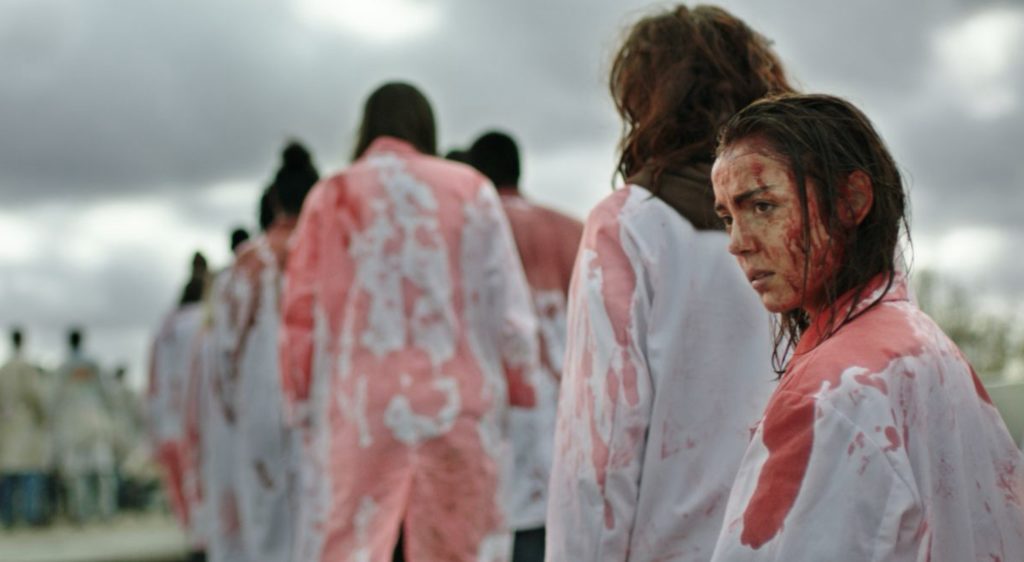Julia Ducournau’s remarkable debut feature Raw is a welcome addition to the cinema of the New French Extremity. The film has already been divisive amongst horror audiences, with some dismissing the film due to the unintended hype that has been surrounding it after a couple of patrons fainted during a screening at the Toronto Film Festival last year. Sure, this makes for some great publicity, and yes there are some scenes in the film that may be challenging for some, but to me this is missing the point of the film. Raw isn’t particularly gross, there are plenty more disgusting films out there, nor is it even especially gruelling to watch, Raw is at it’s core a stunning coming of age film.
Raw is a film which strongly comes from a female perspective. Writer/director Ducournau has crafted a work which manages to reverse the entire construct of the Male Gaze while delivering a platform for the audience to engage with the sexual awakening of a young woman, who also happens to be a cannibal. Over the course of the film we see our protagonist Justine (Garance Marillier) transform from a naive and uncertain girl into a powerful young woman, still struggling but somewhat more easy with herself, her sexuality and her desires. I can’t help thinking that it might be this female perspective that is turning off some of the dismissive critics of the film, as it explicitly portrays this journey of a young woman and her desires.
The film opens with a mysterious car accident, set in a picturesque country road in France. Soon we meet Justine and her parents (Laurent Lucas and Joana Preiss), on route to deliver Justine to the same veterinary school which they attended. We also learn that the family are strict vegetarians. Upon arrival at the school Justine is thrown into the turmoil of Rush Week, in which she and her fellow “Rookies” are put through a series of ordeals by their elder colleagues, of which her older sister Alexia (Ella Rumpf) is one. Justine is reserved and wants to go about her studies. Alexia, the wilder of the two siblings, encourages Justine to break out of her shell, and during an intimate bikini waxing scene things take an unexpected turn, propelling Justine into a new and unknown world of cannibalism and desire.
Garance Marillier’s portrayal of Justine is delicate and refined. The first act sees Justine appearing like a rabbit in the headlights of an oncoming vehicle, uncertain of much but her studies and her love of animals. As the film progresses, Marillier subtly pushes her characterisation until we arrive at the new Justine – focussed and determined to take what she desires. Ducournau’s use of colour and tone is reminiscent of the approach of Dario Argento, supporting the emotions of the characters, or the expectations of the audience with bold colour palettes and striking lighting design. The sound design and use of music is impeccable, reinforcing story and tone, as well as supporting the emotional arc of the film. Ducournau delivers an incredibly assured film as her debut feature.

Thematically Raw deals with the sexual awakening of a young woman, a story often told in cinema, but Ducournau’s treatment of the subject sets it quite apart from the standard coming of age flick. The film aligns less with genre pieces like Carrie, than with other French films like Claire Denis’ Trouble Every Day or Marina de Van’s In My Skin, interestingly both made by female directors. As Alexandra West discusses in her excellent book Films of the New French Extremity (McFarland, 2016) these two films sit closely under the banner of cinéma du corps, or cinema of the body. While Trouble Every Day might seem to be closer in spirit to Raw due to both films exploring cannibalism, Marina de Van’s In My Skin could be Raw’s sister film, as it explores female desires in a similarly bodily way and with a similar amount of confidence and boldness. It would be remiss of me not to mention the oeuvre of David Croneneberg in this context, as his earlier films centred around the cinéma du corps like few others, and his influence in this sub-genre is clear. Raw contains aspects of shocking body horror, but the main confrontation comes from Justine’s explicit determination to achieve her desires. Her bold femininity challenges the audience, demanding they participate in her new experience of the world. Like the backlash to the female lead remake of Ghostbusters, perhaps it is this very reversal of expected female behaviours that is causing certain critics to reject this film.
Ducournau also channels a direct line to what Barbara Creed terms ‘the primal uncanny’. In her book Phallic Panic (Melbourne University Press, 2005), Creed asserts that cannibalism is characteristic of psycho-sexual development, stating “insofar as biting signifies a sexually pleasurable activity, it is associated with cannibalism.” Whereas historically the female lead in horror films have been victims of the male predators, Raw inverts this trope explicitly. One scene delivers this message impeccably; Justine is at a party, while everyone else is dancing she scouts the room, very much the aggressor, very much the dominant figure in the room.
It is telling that Raw’s pivotal narrative event comes during an intimate scene between the sisters. Alexia chastises Justine for her lack of personal grooming, and insists on waxing Justine’s bikini line. The camera lingers, the torment of the act is evident. Alexia mutters “beauty is pain” as Justine reels in agony. In an interview with Jezebel, Ducournau relates how this scene was intended to create the sense of universality that is often lost with female characters. Ducournau strives to transform the bodily representation of a woman, one that is usually sexualised or glamorised, therefore lacking in universal accessibility. She processes traditionally feminine motifs (hair, skin, beauty) through the cinematic lens, and transforms them into visceral horror, allowing the audience to relate to her, whatever gender they might identify as.
As the film progresses Justine finds that her newfound sense of power and control, as well as the actions she takes while in this state, are confronting to the audience – her peers at the vet school as well as the audience in the cinema. The steps she takes to achieve her new agency ostracise her from her colleagues, she is shunned and judged and must understand that she needs to suppress her desires for her own self-preservation. The allegory is clear, strong women confront society. Although her animalistic behaviours result in disgust and her drive is provocative and unacceptable, Justine must find a way to balance her new life. She must find a solution.
There have been many outstanding female-driven genre films of late, and Raw stands tall amongst them. Hopefully Raw will be able to transcend it’s genre constriction and reach a wider audience. Aspects of the film may be a challenge to some, but the masterful delivery by the director and cast should engage all cinema-lovers. It is great to see yet another incredibly strong feminist genre film, as female directors have definitely been creating the most interesting genre cinema of late. Raw is one of the strongest and most affecting films of the year so far. I hope the hype surrounding the film doesn’t work against it. Raw is an outstanding film, and as a debut feature shows much promise for the career of Julia Ducournau. This film is deserved of the praise it has garnered and I think it is an important piece of feminist cinema within any genre.
Raw screens nationally from April 20. Cinema Nova presents a preview screening followed by a panel featuring Emma Westwood, Clem Bastow, Barbara Creed, Philippa Hawker and Cerise Howard, discussing ‘horror in the eyes of women’ on April 19th.




